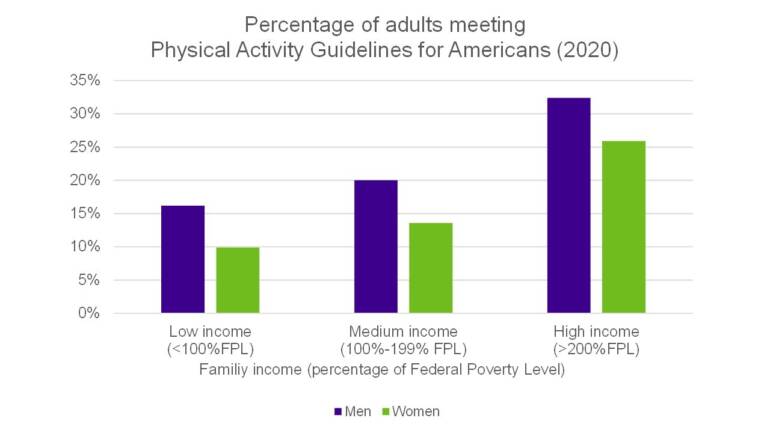Question:
Is there a difference in levels of physical activity between socio-economic groups in the US?
Answer:
Yes, looking at data from the 2020 National Health Interview Survey – a nationally representative survey of 27,000 adults – people from low income families are much less likely to meet the Physical Activity Guidelines for Americans.
The 2018 Physical Activity Guidelines for Americans recommends: at least 150 to 300 minutes a week of moderate-intensity, or 75 to 150 minutes a week of vigorous-intensity aerobic activity (or equivalent combination); and activities of moderate or greater intensity involving all major muscle groups on 2 days a week or more. The chart below shows the percent of individuals from the 2020 National Health Interview Survey who meet the from three income brackets (described by how their family incomes compare to the Federal Poverty Level, FPL).

Source: 2020 National Health Interview Survey, Elgaddal N, Kramarow EA, Reuben C. Physical activity among adults aged 18 and over: United States, 2020. NCHS Data Brief, no 443. Hyattsville, MD: National Center for Health Statistics. 2022., Figure 4.
Note: For an individual in the 48 contiguous states and the District of Columbia:
- In 2025 100% FPL was $15,650 and 200% FPL was $31,300 per year
- In 2020, 100% FPL was $12,760 and 200% FPL was $25,520 per year
Key takeaways
- In 2020, only 24% of adults aged 18 and over met the 2018 Physical Activity Guidelines for Americans for both aerobic and muscle-strengthening activities.
- Significantly more high income individuals meet the Physical Activity Guidelines than low income individuals
- More men meet the Physical Activity Guidelines than women
- Even among the highest income group, less than 40% reach the Physical Activity Guidelines
The fact that people from higher income households are, on average, more active could partially explain why we see greater longevity for higher income individuals, it could also be storing up greater future disparities in the longevity pipeline. With the well documented health benefits of exercise and physical activity, it is worrying to see so few people in the US meeting the level of activity recommended by the Physical Activity Guidelines – although it does mean that there is plenty of headroom for improvements!
The key questions are
- Are there any big drivers of changes in physical activity levels on the horizon? (Wearable technology? Walkable cities? Increased awareness? AI personal trainers?)
- How will any such drivers affect different socio-economic groups? Will they close the gap, or widen it further?
What do you think?
Join the discussion on LinkedIn.
Follow us on LinkedIn
Join us on LinkedIn to stay up-to-date




